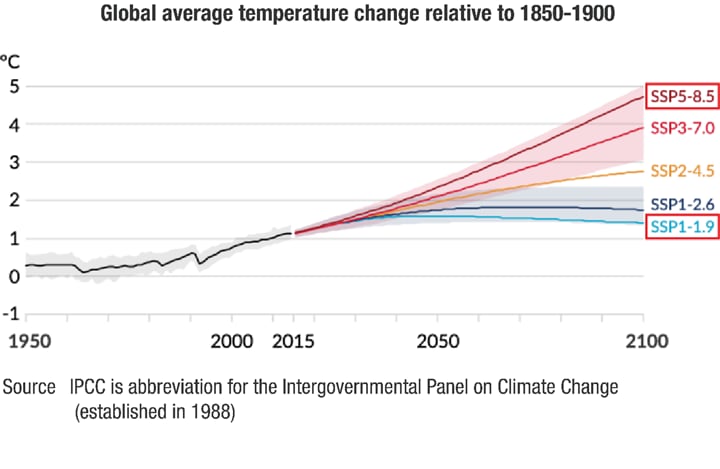Strategy for Addressing Climate Change
Strategy for Addressing Climate Change
Hitachi High-Tech Group has analyzed climate-related impacts with 1.5°C and 4°C scenarios and identified issues on our business which may emerge during the transition to a decarbonized economy. Those scenarios were applied to our three businesses. We classified the consequence of issues in three categories based upon the impact on management: large, medium, and small. We also categorized the period which the issues affect our business into three terms: long term (targeting FY2050, which is the final fiscal year of Hitachi Environmental Innovation 2050), medium term (targeting FY2030), and short term (targeting FY2024, which comes under the Mid-Term Management Plan).
*Please refer to the followings for details (business environment forecasts, initiatives) about the scenario analyses of the three businesses.
Short-Term, Medium-Term, and Long-Term Periods
When analyzing climate change risks and opportunities, there are three classifications of period: short term, medium term, and long term. These are defined as follows.
| Classification | Period | Definition |
|---|---|---|
| Short term | 3 years | Three years between FY2022 and FY2024 (management period according to the 2024 Environmental Action Plan, which defines the three-year period for environmental activities to match the 2024 Mid-Term Management Plan) |
| Medium term | To FY2030 | Up to FY2030, to match the Hitachi long-term environmental targets for FY2030 |
| Long term | To FY2050 | Up to FY2050, to match the Hitachi long-term environmental targets for FY2050 |
Impact of Risks and Opportunities
When analyzing climate change risks and opportunities, there are three classifications of impacts: large, medium, and small. These are defined as follows.
| Impact | Definition |
|---|---|
| Large | Impact leads to cessation of business or significant contraction or expansion of business |
| Medium | Business is impacted in some extent; however, impact does not lead to significant contraction or expansion of business |
| Small | Little or no impact |
Selected Climate Scenarios (Transition Risks)
We referred various scenarios to study how societal demand and government regulations will progress toward climate change mitigation, and eventually selected three scenarios.
| Category | Scenario name | Explanation |
|---|---|---|
| 1.5°C scenario |
IEA SDS | Sustainable Development Scenario (SDS) is one of the main IEA scenarios. It addresses climate change while taking stable energy supply into consideration. |
| 4°C scenario |
IEA STEPS | Stated Policies Scenario (STEPS) is another main IEA scenarios. It is based on national commitments for reduction targets and climate change measures from 2020 under the Paris Agreement. |
| IEA CPS | This scenario considers only those policies that had implementation measures officially adopted as of mid-2015 and hypothesizes that these policies are maintained without being strengthened. |
IEA: International Energy Agency
Selected Climate Scenarios (Physical Risks)
The scenario introduced for physical risks was the shared socioeconomic pathways (SSP) scenario by the Intergovernmental Panel on Climate Change (IPCC) on the matter of what changes would occur in the frequency and impact of meteorological disasters that come with climate change. Two scenarios were selected for 1.5°C and 4°C scenarios.
| Category | Reference value | Envisioned future environment |
|---|---|---|
| 1.5°C scenario | SSP1-1.9 | Climate policy is adopted that holds warming down below 2°C (median value) with reference to pre-industrialization under sustainable development conditions. The prospect is for net zero CO2 emissions in the last half of the 21st century. |
| 4°C scenario | SSP5-8.5 | A high-level reference scenario in which climate policy is not adopted under conditions of fossil fuel-dependent development. |

Main Risks and Opportunities Related to Climate Change
Climate change risks were analyzed based on the scenario conditions defined above with a reference to the Practical Guide for Scenario Analysis in Line with the TCFD Recommendations from the Ministry of the Environment.
- Risks related to the transition to a decarbonized economy, which occur in the 1.5°C scenario
- Risks related to the physical impact accompanying climate change, which occur in the 4°C scenario
| Category | Main risks | Period when risk emerges | Main responses to the risk |
|---|---|---|---|
| Policy and regulation |
|
Short term to long term |
|
| Technology |
|
Short term to long term |
|
| Market reputation |
|
Short term Medium term |
|
| Category | Main risks | Period when risk emerges | Main responses to the risk |
|---|---|---|---|
| Acute Chronic |
|
Short term Medium term |
|
| Category | Main opportunities | Responses to main opportunities |
|---|---|---|
| Products and services |
|
|
| Resource efficiency |
|
|
| Energy |
|
|
The links below shows the details (business environment forecasts, initiatives) of the scenario analyses for the three businesses.
